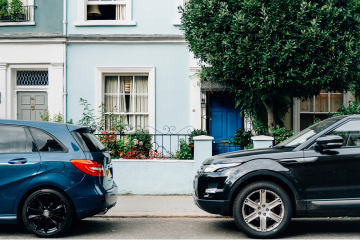If you have a car insurance policy, you may already know about car insurance excess. You may also know that you can increase it to lower your car insurance costs.
But not everyone knows what it’s actually for or the difference between voluntary and compulsory excesses. Here, we explain everything you need to know about compulsory and voluntary excess.

What is car insurance excess?
So, car insurance excess is a set amount you have to pay if you make a claim on your car insurance policy. There are 2 types of excess (or sums of money) that merge to create your total excess - compulsory and voluntary.
If your total excess is £400 and you make a claim for £1,000, your insurer usually keeps the first £400. That leaves you with the remaining £600.
What does compulsory excess mean?
Your compulsory excess is fixed by your insurance company - there’s no opportunity to change it. However, this doesn't prevent you from comparing car insurance quotes to find a policy suitable for you with a desired compulsory excess amount.
If you’re a young or inexperienced driver, your compulsory excess may be higher than someone who's older or more experienced at driving.
This is because new and young drivers fall into a higher-risk category, so there’s usually extra excess added. This should be clearly noted in your policy.
You might also have additional excess to pay if you drive a luxury or high-performance car.
What does voluntary excess mean?
The key word here is 'voluntary'. This is an amount you’re willing to pay towards the cost of a claim. By its very nature, voluntary excess is variable - meaning it can be adjusted by you accordingly.
When you get a car insurance quote, it’s worth looking at how changing the voluntary excess affects your price. Then, choose an amount that you’re comfortable with.
You do have the option of paying no voluntary excess, although it's likely that your car insurance premium will be adjusted to reflect this.
Generally, the more you're willing to contribute towards a claim in the form of voluntary excess, the less you're likely to pay for your policy.
But remember, if you make a claim, you might have to pay both the voluntary and compulsory excess. This means it’s important to set an amount you're confident you can pay.
What's the difference between voluntary and compulsory excess?
The easiest way to explain the difference is that compulsory excess is fixed by your insurer, whereas voluntary excess is set by you.
Both of these amounts combine to create your total excess, this is contributed in the event of a claim. When you arrange your policy, your insurance company should make it clear exactly how much excess you need to pay.
Can I change my voluntary excess?
Yes, you can adjust your voluntary excess - it’s an amount you agree with the insurance company.
When you compare car insurance through us, you can experiment with different voluntary excess amounts and see what impact it has. This can have an impact on what you pay for your car insurance policy.
Should I increase my voluntary excess?
It's entirely up to you, but it's worth bearing in mind what impact it has.
Increasing your voluntary insurance tends to reduce the cost of your car insurance quote, but you'll have to pay this amount in the event of a claim.
If you do increase your voluntary excess, remember that it could reduce your likelihood of claiming. This means you end up paying more repair bills yourself.
Let's say you have a compulsory excess of £250 and a voluntary excess of £500. That means any claim would have to be worth more than £750 to make it worthwhile.
When do you pay excess on car insurance?
You pay your compulsory and voluntary car insurance excess when you make your car insurance claim.
If you’re only involved in a minor road accident, you might find that your total excess is more than the cost of repairing the car.
This is even more likely if you’ve chosen to increase your voluntary excess. In these cases, you have to decide if it’s worth claiming on your insurance at all.
Remember that you should let your insurer know about any accident you have, even if you don’t claim.
Will I have to pay the excess if the incident wasn’t my fault?
If you make a claim that's deemed to be someone else’s fault, your insurer might decide to pay your claim in full. They may also waive your excess.
This isn't a definite outcome though. So check the terms and conditions of your policy to find out if your insurer does this.
I don't want to change my excess, how else can I lower my insurance?
If you decide that you’d rather not risk taking on a higher excess, there are other ways to lower your car insurance costs:
Improve your car’s security
Beefing up your car's security measures can work in your favour when it comes to the cost of car insurance. Whether it's a steering wheel lock, dash cam or wheel clamp, additional security measures can help deter the risk of car theft.
Shopping around and comparing prices
Before committing to your renewal, try shopping around. We’ve found that buying around 3 weeks before your policy start date is significantly cheaper than any other time*. That way you can ensure you're getting the best deal.
Building up your No claims bonus (NCB)
You can build your NCB for each year you go without making a claim. Over time this can help lower your car insurance premiums. You could pay to protect your NCB. This means you can make a set amount of claims without losing your NCB.
Paying annually
Insurance providers tend to charge interest for spreading costs over a monthly basis, this isn't the case when paying annually. So, paying for your insurance in one lump sum rather than monthly can actually work out as a cheaper option - if you can afford to do so!
How is excess insurance different to voluntary and compulsory excess?
Motor excess insurance isn’t an excess. It's a standalone insurance policy that covers the cost of any excess you may need to pay on a car insurance claim.
It's often popular among new drivers who have large compulsory excesses on their car insurance.
Compare car insurance quotes
*Confused.com data Q4 2024







